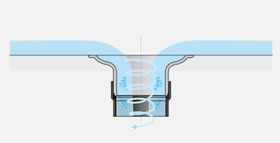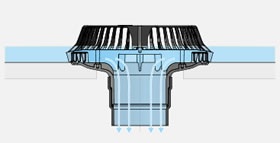IN COMPARISON WITH CONVENTIONAL SYSTEMS
There are two types of rainwater drainage systems: conventional systems that are incorrectly called gravity systems, and the Rainplus® siphonic system, which is also known as vacuum system or full section system.
A conventional drainage system can be designed for large surfaces but does not cut off air flow into the pipe. For this reason pipes are sized for filling ratios of 20% or 33% (depending on national or local standards and regulations) allowing considerable amounts of air into the pipes up to 80% or 67% of the pipe section.
In conventional roof drainage, outlets are simple “funnels” installed on the roof covering and connected to the downpipes which are as high as the building and water collectors, which require a gradient of at least 1%, are dimensioned for a maximum filling factor of 70%.
When water collectors are very long and it is not possible to provide the minimum slope necessary due to the limited space available, the only solution is to increase the size of the pipes with a consequent rise in installation costs.
Both use the force of gravity but in a decidedly different manner, resulting in differences in performance, design and calculation.



